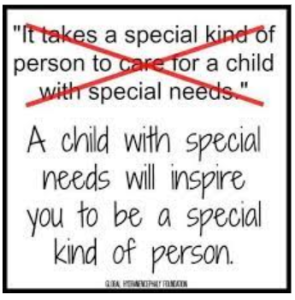With the Right to Education Act, our schools have opened up to students with different abilities. This is both heartening and uplifting, as the school ecosystem can help CWSN (Children With Special Needs) and atypical children across ages and grades learn alongside one another, accept differences, acknowledge strengths, and work toward overcoming challenges.
However, this also means that, as staff, we need to enhance our methods to include them effectively. The library has historically been a safe space for all students, opening their minds by opening books. Books have offered solace, comfort, acceptance, and learning. Librarians have been the custodians of this unique power. Thus, it becomes even more important for us as librarians to extend this special space to CWSN.
“The library should be an inviting and safe space, especially for neurodivergent/disabled children. It’s one of the only times students can make choices about what they get to learn.” – Meghan Ashburn, Make the School Library More Accessible to Autistic/Disabled Kids
So how do we make our Libraries welcoming to students with CWSN
Know Your CWSN Students:
– They are our students, whether they visit the library with their classmates, come with aides, or come alone.
– Talk to your teachers who work with CWSN, or request a meeting with them.
– Better yet, invite the teachers to the library!
– Prepare a small questionnaire. Include questions about their reading abilities, interests, preferred language, strengths, challenges, behavioral or sensory issues, the best times for them to visit, how to communicate with them, and what motivates them. Listen carefully and build your questions based on their responses.
– Learn how they prefer to be addressed. For example, Sai Kiran in Grade 5 may be called Kiran, while Sai Kiran in another grade might be known as Sai. This distinction is important for all children, especially CWSN.
Get to Know Your Teachers and Staff
Understand the roles and responsibilities of shadow teachers, behavior therapists, and assistant teachers. Observe their interactions with students and reach out directly if you have concerns. For example, a G11 student with ASD would stand very close when talking to me. I was unsure how to ask him to step back, but his teacher did so gently and firmly, and he complied without protest. She explained that this approach works, even if it requires repetition. This guidance helped me interact with him more effectively.
Share Your Timetable:
I know it’s difficult when we have little to no planning time and are fully booked. However, try to schedule at least some time each month. I usually allocate half-time slots (20 minutes) instead of a full period.
Know Your Resources
Now that you know your CWSN students and have scheduled time for them, prepare just like you would for any class. Initially, let the students explore the library. Many CWSN have never entered the school library before. Allow their teacher to guide them and then join in later. Introduce yourself; wearing a name tag or giving them an index card with your name can help.
Activities that work for other children often work for CWSN too, even if their understanding may differ. Interaction with an adult other than their usual teachers is a big step for many CWSN. Start with low-interaction activities like browsing books or coloring bookmarks. Gradually move on to read-aloud sessions or storytelling. Some students with ASD enjoy shelving books. Always coordinate with their teachers. For example, one student with ASD loved arranging books by color-coded spine labels and straightening them on the shelf.
For many of my students, I always repeat my name and remind them that the library has books they can read or look at pictures. I always let them borrow books too. If you are concerned about the books, pre-select them. Let them borrow for the day and return them at the end of the day, gradually allowing them to take books home.
Many CWSN have volunteered to stamp books. Keep a box of old magazines, board books, donated books, coloring books, workbook-style teacher sample books, and art and craft sample books for low-functioning CWSN.
Help them feel responsible in the library. For example, one student enjoyed collecting daily newspapers from security and delivering them to the library. With his aide teachers, we built this into a routine he could do independently, including placing the newspapers in stands around the school. For many non-verbal students, especially those with ASD, routine tasks help create a sense of structure and inclusion.
Document your efforts. If you are starting out, keep a small document or notebook to record daily or weekly interactions, even if it’s just conversations with teachers working with CWSN. With permission, take pictures and keep them in your resource folder for later sharing.
Reducing Lights
I often keep the lights off in certain areas to naturally cordon off spaces. Fluorescent lights can be overwhelming sensory stimuli for many children. Lowering the lighting makes the library feel more intimate and less overwhelming.
Build Your Resources
Based on your documentation, expand your collection and include resources in your budget according to the needs of your CWSN. Some easy-to-procure resources include large print books, board books, touch-and-feel books, and interactive books. One student with ASD loved the picture dictionary. Other favorites include step-by-step cooking books with pictures, art and craft books, and model-making books.
Library Staff Training
Share your learnings with other library staff. Emphasize the importance of empathy, effective communication techniques, and correct terminologies.
Create a Feedback Mechanism
Set up an online form for special education teachers or check in with them directly to see how you can better support them or address any concerns about library experiences. Extend this feedback process to parents, especially during parent-teacher meetings (PTM).
 Most of this article is based on my experiences. I would love to hear how you make this work in your libraries. What resources have you used to include CWSN? Share your insights and keep this conversation going.
Most of this article is based on my experiences. I would love to hear how you make this work in your libraries. What resources have you used to include CWSN? Share your insights and keep this conversation going.
For more perspectives, read “Make the School Library More Accessible to Autistic/Disabled Kids” by Meghan Ashburn, which provides a mom’s point of view.
by Sushweta Saha
Senior School Librarian,
The Shri Ram Universal School


The anecdotes were wonderful examples!